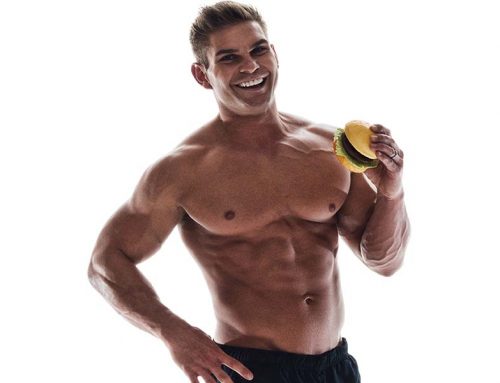Until recently, mindfulness had been nothing more than an abstract concept to me. Something the ultra spiritual and silicon valley folks did. In the past few years, however, I started paying more attention. My curiosities led me to exploring the implications of mindfulness and health, mindfulness and fat loss, how an ADHD-prone scatterbrain like me might benefit from it, and how my clients could implement it to improve their lives.
Let’s take a deeper dive into mindfulness: What it is, its general health benefits, how it can help with fat loss, as well as some simple, effective ways to implement mindfulness into your daily life.
Mindfulness: A Working Definition
Mindfulness is essentially defined as a state of active, open attention in the present where you observe your thoughts and feelings from a distance, without judging them as good or bad.
The Chinese character for “mindfulness” is “nian” (念). It is a combination of two separate characters , each with its own meaning. The top part of the character means “now” and the bottom part means “heart” or “mind”. Literally the combined character means the act of experiencing the present moment with your heart. Mindfulness then, is moment-to-moment awareness of what is occurring in us and around us.
Noted psychiatrist and neurobiologist Dr. Jud Brewer says this about mindfulness: “mindfulness is just about being really interested in getting close and personal with what’s actually going on in our bodies and minds. A willingness to turn towards our experiences—rather than trying to suppress them. It’s about approaching our demons with curiosity—which is naturally rewarding.”
Often linked with meditation, the 2 concepts are similar and complementary – but also distinct. Meditation is generally a more formal and structured practice, while mindfulness is about being aware. The difference may be best described this way: Mindfulness is the awareness of “some-thing,” while meditation is the awareness of “no-thing.”
Mindfulness: Great for Mental Health
Mindfulness, as it turns out, has a pretty substantial body of evidence behind it when it comes to both mental (and by extension) physical health benefits, including: Reduced symptoms of anxiety, increased cognitive function and immune response. Overall, there is pretty robust evidence that links mindfulness practice to improved psychological health. It’s no wonder it is becoming more mainstream and accepted – even in the ivory towers of academia.
Mindfulness is a vast topic and as such I will attempt to boil it down into the essentials and actionables from the perspective of someone with a busy brain and not super “spiritual”. I will discuss:
- A mindfulness starting guide for the busy and easily distracted
- Mindfulness for eating and moving
- Mindfulness as a fat loss tool
- My top 3 mindfulness techniques
Mindfulness: Here’s Where To Start
“Mindfulness practice does not need to be another “add-on.” Its beauty lies in the fact that it can be fully and easily integrated into every act of our daily living, reminding us to live the present moment fully.”
― Thích Nhất Hạnh, Savor: Mindful Eating, Mindful Life
If you are new to mindfulness like I am, try dedicating even a few daily minutes to the practice. Two of the greatest misconceptions about mindfulness and meditation is that:
a) You need to do it for a set amount of time to benefit from it.
b) You should be completely clear of any thoughts while trying to practice.
In the early going especially, you may find your mind is abuzz with activity—”What will I wear to that work presentation I need to give”…”who’s getting the kids to piano this week?”…”Why do they keep making “Fast and Furious movies?”. This is normal so don’t sweat it. Focus first on slowing down the breathing. Bring a sense of calm over your body as best you can. Get into a quiet, electronic-free, distraction-free place and just sit—on the floor, in a chair, on a bed—doesn’t matter.
Here’s a simple “mindfulness for noobs” exercise you can partake in, which only takes a few minutes:
- Sit in a chair in a quiet room with your eyes closed
- Don’t worry too much about your breathing rate/depth but notice it… Notice the inhalation and exhalation. Notice the structures around your breathing… Your shoulders, your ribcage, your chest.
- Notice how they move with each breath.
- Begin thinking about your feet. Feel the sensation of them on the ground. Move up to your knees, your hips, your abdomen and circle back to the breathing.
- Repeat this for several breaths – as many as you feel comfortable with. Eventually you will be able to do this for longer stretches of time.
Mindfulness and Eating
Mindful eating means simply eating or drinking while being aware of each bite or sip.
The goal being to elicit a multisensory experience of eating – a heightened awareness of what, and how much we are consuming.
The goal here isn’t to turn every bite into a hyper-spiritual experience where you feel the presence of angels and Gods of every religion permeate your soul (this only works with tacos). Rather, it is bringing a consciousness to consumption and averting the thoughtless stuffing of the face that is commonplace in our rushed, hyperpalatable food environment.
While the eventual goal might be to make every bite and sip a mindful experience, reality dictates that our noisy brains may not allow for it. Therefore be patient with the process as the new wiring begins to take shape.
To break this into more manageable chunks, my best suggestion for weaving mindfulness practice into your eating is to start with water. Turn your water consumption into a mindful experience. As you sip the water, take in the sensations – the cold hitting your throat, the refreshing nature of it, the body absorbing it – your cells taking it in. The satisfaction you feel as it quenches your thirst. You are taking it in with your whole body and mind and thinking of nothing else in that moment.
A logical progression would be to start with one meal a day. My suggestion would be breakfast. Take in the aroma, the texture, the sight and the taste of your food. Chew consciously and chew each bite at least 25 times, fully immersing yourself in the experience. (Just don’t chew loudly – nobody likes a “loud chewer”)
Be particularly vigilant when you are feeling negative emotions: Stress, anger, sadness, loneliness or boredom. You will be particularly prone to a) making sub-optimal food choice and b) if you do decide to make a suboptimal food choice, you will be prone to rushing through the experience and in the process eat more than planned. As you chew, leave no room for anxiety, worry or stress. When you choose a healthier option, know that you are nourishing both your body and your soul.
As with all mindfulness techniques it all starts with breathing. Take a few conscious breaths before you engage in the meal or snack. Try and do away with distractions such as smartphones, TV’s or loud music. Engage in conversation if you are dining with family or friends while keeping anchored to the sensory experience of your meal.
My Top 3 Strategies for Mindful Eating
1. Food Gratitude:
For some, this could mean “Grace”, for others it might mean simply saying “thank you” to those who provide the food. In a world of busy-ness and a first world of abundance, it becomes easy to forget how fortunate we are to have food on our plates daily. Acknowledging this can bring a more mindful and respectful form of consumption where we honor our body’s satiety cues.
2. Engaging the Senses:
As alluded to before, when taking in your bites, I’ll encourage you to really engage in the multisensory experience. Notice the visual beauty, the aroma, the texture, the mouthfeel, the taste. Speaking of the aroma and taste, a little known fact of what’s collectively known as the “gustatory” system, we have 2 separate olfactory senses: orthonasal olfaction and retronasal olfaction. The former is what we know as “smell” while the latter is the experience of the flavor of any given food or drink.
3. Eat Slowly, Take Small Bites and Chew Thoroughly:
Ok so there’s actually 3 in there, but they all relate in some way. Eating more slowly and deliberately, taking smaller bites and chewing more than necessary will all contribute to a more mindful food and drink experience. Another benefit being it will lead to less consumption.
Mindful Movement
Like eating, our movement tends to be a “going through the motions” kind of event. Worse yet, for many it represents discomfort and feelings of dread. Further, some forms of exercise lend themselves better to being “mindful” than others (Yoga, Pilates).
Mindfulness in the context of heavy lifting and more vigorous cardio serves 3 main purposes:
1. It allows us to be in the moment of our given exercise
2. It allows us to dissipate and reframe any discomfort. And
3. It allows us to be more in tune with the muscles we are targeting – rendering the exercise more effective. To quote Arnold Schwarzenegger: “You’ve got to be inside the muscle. This is the difference.”
Related: How To Use The Mind To Muscle Connection To Build More Muscle
A before, during and after mindfulness ritual can help you make the most of your sweat sessions.
Before your session: Deep breaths… think about how you want the session to feel. Think about embracing the challenge ahead. Think about what a privilege it is to have a functioning and capable body.
During your session: Think about the muscles that you are working on. If you’re squatting, think about the synergistic forces of your quadriceps, hamstring and glute muscles firing up, your bracing of the midsection, your breathing, the pushing through the heels. When the discomfort strikes, think of the breathing. Always go back to the breathing. Embrace the discomfort. Reframe it as your body’s signal of improvement.
After your session: This can coincide nicely with a post-workout stretch routine. Reflect on the accomplishment as you pay attention to your breathing. Be conscious of the breathing rate and heart rate slowing down. Feel the stretch in your muscles that you are targeting as you take in deep inhalations and exhalations.
Mindfulness and Fat Loss
It turns out there is some solid research showing the benefits of mindfulness and meditation from a weight loss perspective. In a review of 19 studies, interventions based on mindfulness proved “moderately effective for weight loss” and “largely effective in reducing obesity-related eating behaviors.” Interestingly enough, when compared to the “lifestyle change” programs, the mindfulness/meditation intervention had longer lasting results. These practices are likely effective due to the heightened awareness around food, triggers and awareness of hunger and fullness.
Further, a 2014 review of 14 studies found that using mindful meditation was an effective intervention for reducing binge eating and emotional eating. The stress-lowering effects of mindfulness meditation can have psychological benefits which can manifest into physical benefits from an inflammation and hormonal response standpoint.
It stands to reason that being in better control of your emotions can curtail empty calorie food consumption and
My Top 3 Mindfulness Techniques For Everyday Life
Here are a few mindfulness techniques that I have found to be personally effective in diverting from these negative emotions: “surfing the urge”, “leaves on a stream” and “The 5-Finger Breathing Technique”.
1. Surfing the Urge
Urge surfing is a technique developed by Sarah Bowen and Alan Marlatt. This method can be used to avoid acting on any behavior that you want to reduce or stop. In this case we are talking about overeating and staying sedentary but it could be rage, impulse shopping, pornography, drinking or smoking. Here are some things to equip you for surfing the urges.
Urges are short-lived: Rarely do urges last longer than 30 minutes if we don’t feed them. Do your best not to dwell on them, give them attention or justify acting on them. They will feel intense and perpetual in the moment but they will run their course.
Suppressing a thought, feeling or sensation ultimately increases it. Fighting urges (even by trying to talk yourself out of them or distracting from them) often makes them bigger.
You can’t get rid of urges. You can, however practice ways to accept them and ride the proverbial wave out without giving in to them.
Here are some mindfulness techniques to help you surf the urge:
Pay attention to your breathing. Don’t alter it. Let the breath do its work—slowly.
Notice your thoughts and without judging, feeding or fighting your thoughts, gently bring your attention back to the breath.
2. Leaves on a stream
This cognitive defusion exercise, developed by Dr. Russel Harris involves visualizing yourself sitting beside a gently flowing stream with leaves floating along the surface of the water.
For a few minutes, take each thought that enters your mind and place it on a leaf… let it float by. Do this with each thought—pleasurable, painful, or neutral. Even if you have joyous or enthusiastic thoughts, place them on a leaf and let them float by.
If your thoughts momentarily stop, continue to watch the stream. Sooner or later, your thoughts will start up again.
Allow the stream to flow at its own pace. Don’t try to speed it up and rush your thoughts along. You’re not trying to rush the leaves along or “get rid” of your thoughts. You are allowing them to come and go at their own pace.
If your mind starts to wonder and thoughts like, “This is dumb,” or “I’m bored,” start to creep in, place those thoughts on leaves, too. If a leaf gets stuck, allow it to hang around until it’s ready to float by.
3. The 5-Finger Breathing Technique
I snapped up this gem from the above-mentioned Dr. Jud Brewer. This technique can be highly effective for freeing up your “brainspace” by tracing the outside of your pinky finger as you inhale, then trace down that same finger as you exhale. Repeat this step with all fingers then reverse from the thumb. This will bring a multisensory experience as you watch and feel your finger while simultaneously being aware of your breath. It takes a lot of your brain’s capacity to accomplish, which can help shift away the thoughts of worry or anxiety.
Here is a video demonstration by Dr Bewer:
There are also many apps available to help guide you through mindfulness practices. Some of the more popular ones are:
- Insight Timer
- Headspace
- Smiling Mind
- Stop, Breathe & Think
- 10% Happier
Take Home Points
- Mindfulness is the state of active and open attention to the present moment – seeing yourself from an outside perspective in a non-judgemental way. Leaning into our experiences and approaching them with curiosity.
- Mindfulness practices carry with them a myriad of mental and physical health benefits.
- The basics of mindfulness are grounded in breathing. The first step to mindfulness practice is to be still, quiet and slow down the breathing. Paying attention to your feet as the “grounding” force.
- When eating, use mindfulness to bring a consciousness to it. Practice gratitude, take awareness of the multisensory experience of eating and eat slowly – chewing more than necessary.
- When moving intentionally pay attention to the sensation of your body and its parts. Marvel at its capabilities, embrace the discomfort as a sign of progress and reflect on the accomplishment when you are finished your session.
- Take your mindfulness practice in small steps and try to do some form of mindfulness daily – even if it’s only for a few minutes.
-Mike Howard
Announcement. If your goal is fat loss, and you’re looking for a mindset-focused program for getting leaner (not a restricted diet), The new Lean Minded Fat Loss Course by Mike Howard has just opened for enrollment for a limited time. Use the coupon code “Burnthefat” for a 10% discount. Click here to learn more.

With over 20 years of in-the-trenches experience as a personal trainer, online coach, youth fitness specialist, author and presenter, Mike has orchestrated meaningful, individualized solutions to thousands of clients both in Vancouver and around the world.
Mike has gained national and international attention for his philosophies on body composition, youth fitness and matters relating to fitness and nutrition education. He has appeared on TV (CBC and Shaw TV), print (Vancouver Sun, IMPACT Magazine) and has penned over 400 online articles. He has also been the guest on numerous podcasts. Mike has authored 2 books: “Lean Minded: 50 Days to Mind and Body Transformation” and the e-book “Talking Back to Diet Gurus: An Un-revolutionary and Un-Sexy Guide to Fat Loss” and he is the creator of “The Lean Minded Fat Loss Course.” Click Here To Learn More (10% discount with coupon code “burnthefat”)






Leave A Comment